HR Function: Managing, Coordinating, Evaluating & Human Capital
VerifiedAdded on 2023/06/10
|9
|1948
|493
Report
AI Summary
This report provides a comprehensive overview of the human resources (HR) function within organizations, emphasizing its crucial role in achieving organizational objectives. It discusses how HR contributes to performance, change management, and administration, highlighting key objectives such as building organizational capability, staffing effectively, and promoting ethical behavior. The report also examines methods for evaluating HR's contribution, including balanced scorecards, benchmarking, KPIs, and SLAs. Furthermore, it explores the impact of investing in human capital on organizational practices, focusing on the relationship between high-performance work practices and job satisfaction, ultimately linking these practices to the achievement of organizational goals. The analysis underscores the importance of continuous feedback, talent pool creation, and a supportive work environment in enhancing employee performance and organizational success. Desklib offers this document along with a wealth of study resources for students.
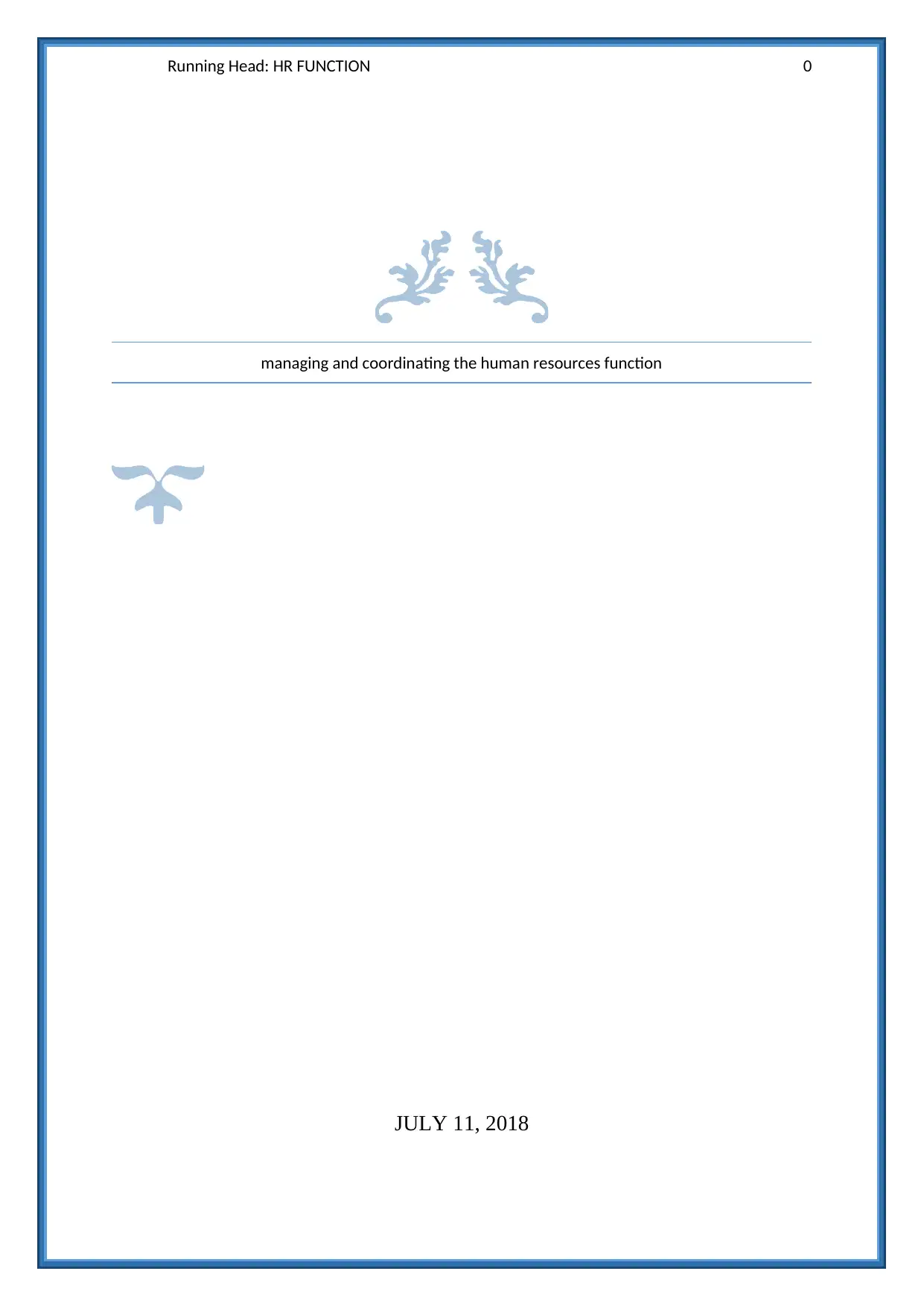
Running Head: HR FUNCTION 0
managing and coordinating the human resources function
JULY 11, 2018
managing and coordinating the human resources function
JULY 11, 2018
Paraphrase This Document
Need a fresh take? Get an instant paraphrase of this document with our AI Paraphraser
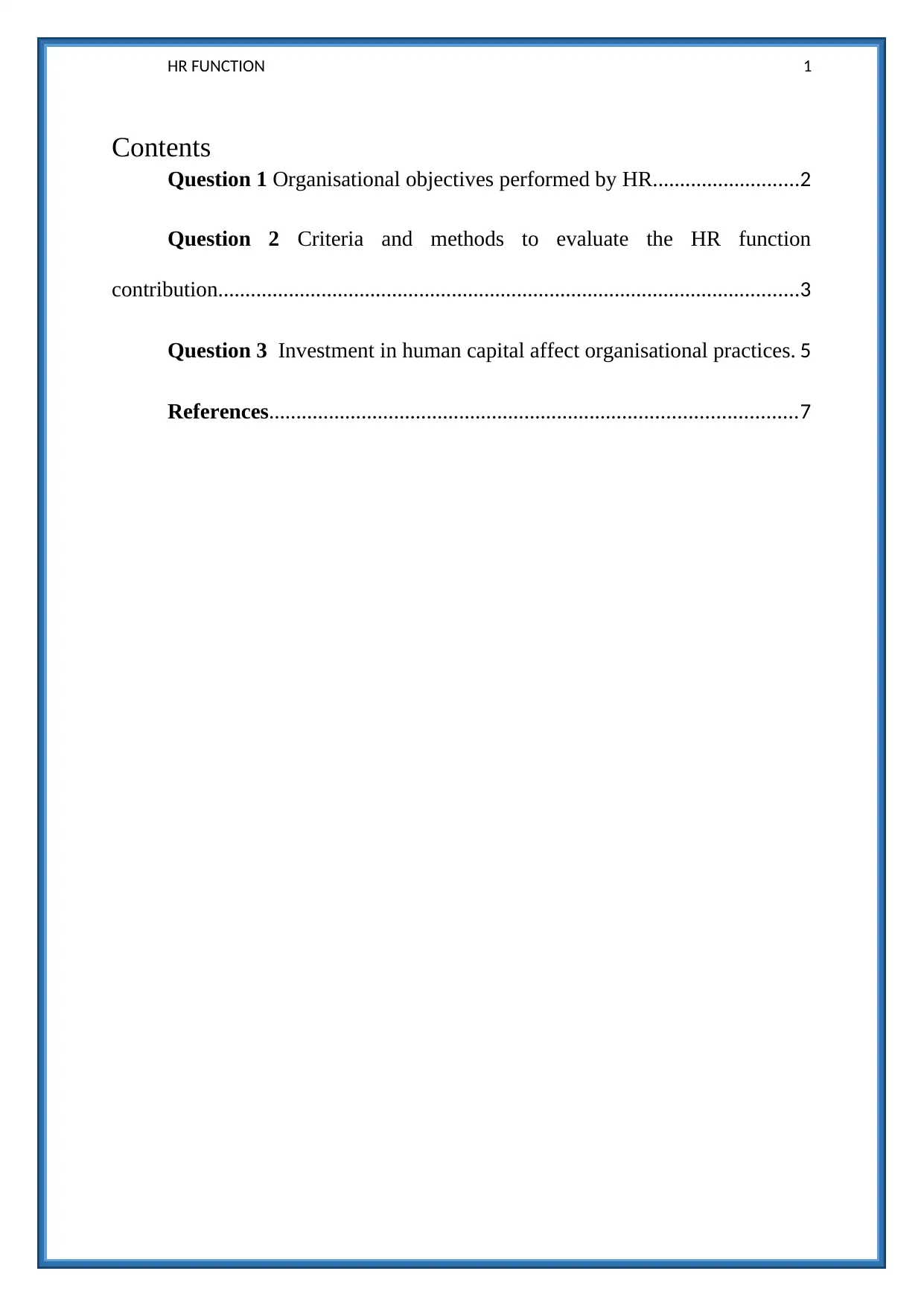
HR FUNCTION 1
Contents
Question 1 Organisational objectives performed by HR...........................2
Question 2 Criteria and methods to evaluate the HR function
contribution...........................................................................................................3
Question 3 Investment in human capital affect organisational practices. 5
References.................................................................................................7
Contents
Question 1 Organisational objectives performed by HR...........................2
Question 2 Criteria and methods to evaluate the HR function
contribution...........................................................................................................3
Question 3 Investment in human capital affect organisational practices. 5
References.................................................................................................7
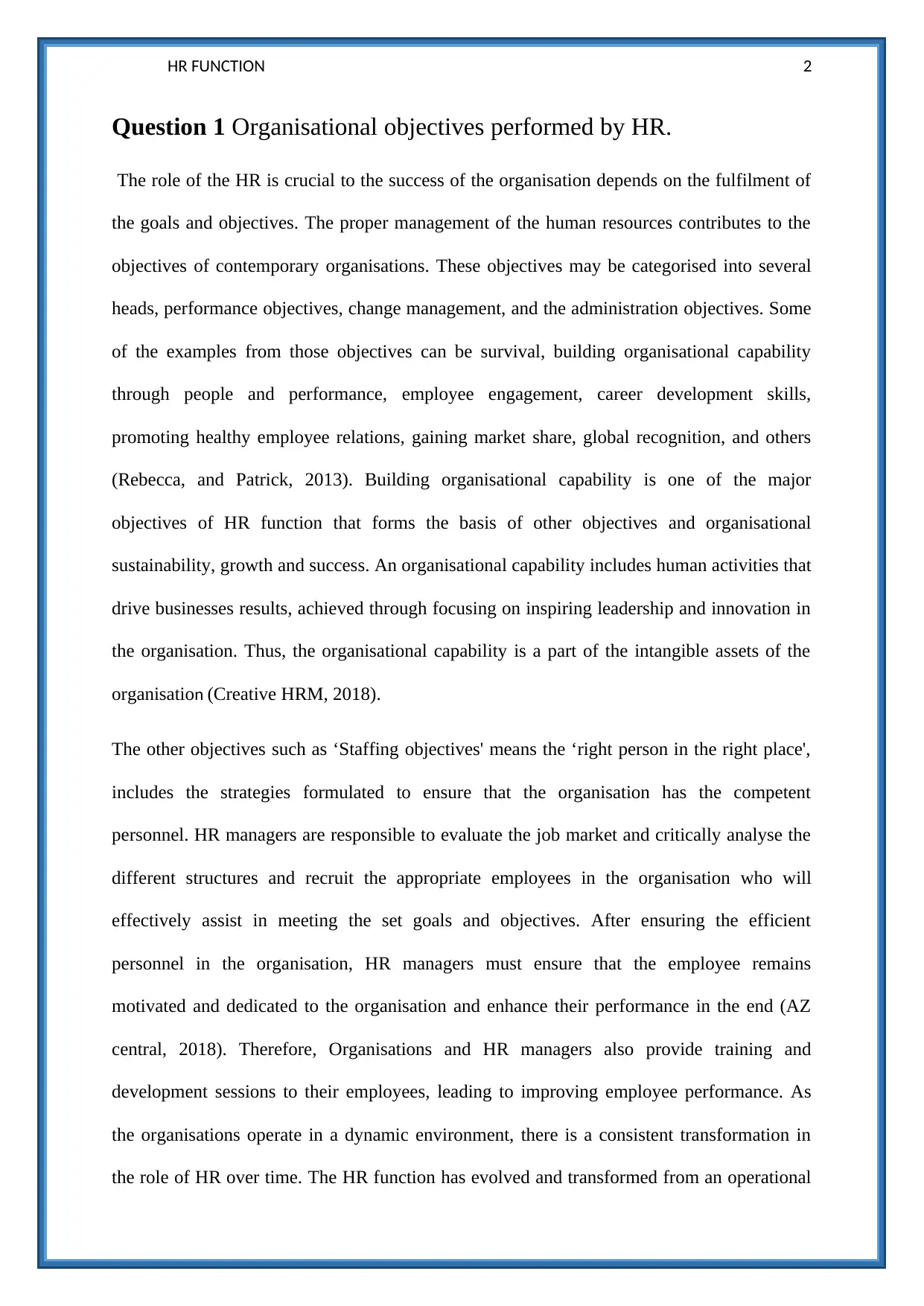
HR FUNCTION 2
Question 1 Organisational objectives performed by HR.
The role of the HR is crucial to the success of the organisation depends on the fulfilment of
the goals and objectives. The proper management of the human resources contributes to the
objectives of contemporary organisations. These objectives may be categorised into several
heads, performance objectives, change management, and the administration objectives. Some
of the examples from those objectives can be survival, building organisational capability
through people and performance, employee engagement, career development skills,
promoting healthy employee relations, gaining market share, global recognition, and others
(Rebecca, and Patrick, 2013). Building organisational capability is one of the major
objectives of HR function that forms the basis of other objectives and organisational
sustainability, growth and success. An organisational capability includes human activities that
drive businesses results, achieved through focusing on inspiring leadership and innovation in
the organisation. Thus, the organisational capability is a part of the intangible assets of the
organisation (Creative HRM, 2018).
The other objectives such as ‘Staffing objectives' means the ‘right person in the right place',
includes the strategies formulated to ensure that the organisation has the competent
personnel. HR managers are responsible to evaluate the job market and critically analyse the
different structures and recruit the appropriate employees in the organisation who will
effectively assist in meeting the set goals and objectives. After ensuring the efficient
personnel in the organisation, HR managers must ensure that the employee remains
motivated and dedicated to the organisation and enhance their performance in the end (AZ
central, 2018). Therefore, Organisations and HR managers also provide training and
development sessions to their employees, leading to improving employee performance. As
the organisations operate in a dynamic environment, there is a consistent transformation in
the role of HR over time. The HR function has evolved and transformed from an operational
Question 1 Organisational objectives performed by HR.
The role of the HR is crucial to the success of the organisation depends on the fulfilment of
the goals and objectives. The proper management of the human resources contributes to the
objectives of contemporary organisations. These objectives may be categorised into several
heads, performance objectives, change management, and the administration objectives. Some
of the examples from those objectives can be survival, building organisational capability
through people and performance, employee engagement, career development skills,
promoting healthy employee relations, gaining market share, global recognition, and others
(Rebecca, and Patrick, 2013). Building organisational capability is one of the major
objectives of HR function that forms the basis of other objectives and organisational
sustainability, growth and success. An organisational capability includes human activities that
drive businesses results, achieved through focusing on inspiring leadership and innovation in
the organisation. Thus, the organisational capability is a part of the intangible assets of the
organisation (Creative HRM, 2018).
The other objectives such as ‘Staffing objectives' means the ‘right person in the right place',
includes the strategies formulated to ensure that the organisation has the competent
personnel. HR managers are responsible to evaluate the job market and critically analyse the
different structures and recruit the appropriate employees in the organisation who will
effectively assist in meeting the set goals and objectives. After ensuring the efficient
personnel in the organisation, HR managers must ensure that the employee remains
motivated and dedicated to the organisation and enhance their performance in the end (AZ
central, 2018). Therefore, Organisations and HR managers also provide training and
development sessions to their employees, leading to improving employee performance. As
the organisations operate in a dynamic environment, there is a consistent transformation in
the role of HR over time. The HR function has evolved and transformed from an operational
⊘ This is a preview!⊘
Do you want full access?
Subscribe today to unlock all pages.

Trusted by 1+ million students worldwide
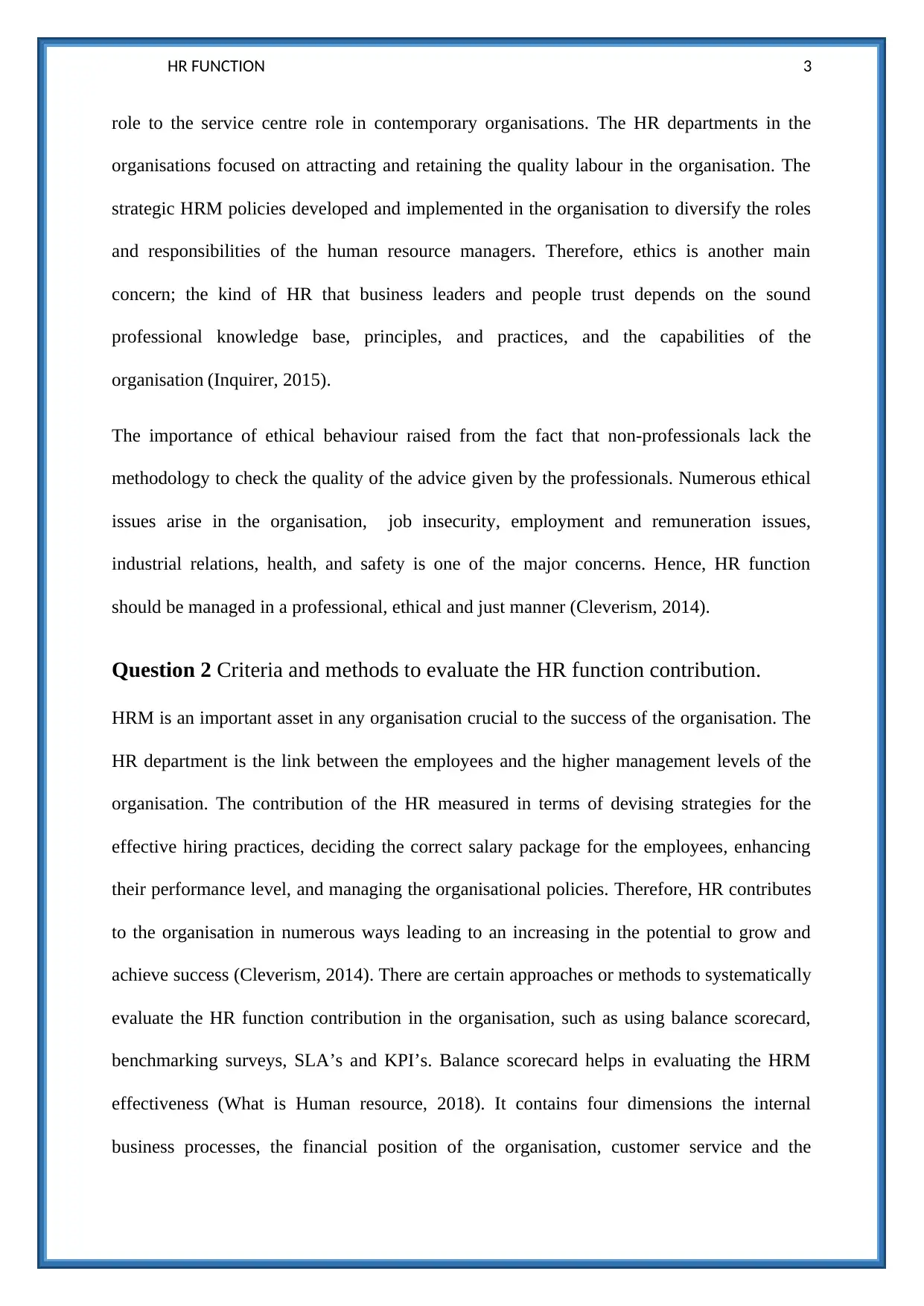
HR FUNCTION 3
role to the service centre role in contemporary organisations. The HR departments in the
organisations focused on attracting and retaining the quality labour in the organisation. The
strategic HRM policies developed and implemented in the organisation to diversify the roles
and responsibilities of the human resource managers. Therefore, ethics is another main
concern; the kind of HR that business leaders and people trust depends on the sound
professional knowledge base, principles, and practices, and the capabilities of the
organisation (Inquirer, 2015).
The importance of ethical behaviour raised from the fact that non-professionals lack the
methodology to check the quality of the advice given by the professionals. Numerous ethical
issues arise in the organisation, job insecurity, employment and remuneration issues,
industrial relations, health, and safety is one of the major concerns. Hence, HR function
should be managed in a professional, ethical and just manner (Cleverism, 2014).
Question 2 Criteria and methods to evaluate the HR function contribution.
HRM is an important asset in any organisation crucial to the success of the organisation. The
HR department is the link between the employees and the higher management levels of the
organisation. The contribution of the HR measured in terms of devising strategies for the
effective hiring practices, deciding the correct salary package for the employees, enhancing
their performance level, and managing the organisational policies. Therefore, HR contributes
to the organisation in numerous ways leading to an increasing in the potential to grow and
achieve success (Cleverism, 2014). There are certain approaches or methods to systematically
evaluate the HR function contribution in the organisation, such as using balance scorecard,
benchmarking surveys, SLA’s and KPI’s. Balance scorecard helps in evaluating the HRM
effectiveness (What is Human resource, 2018). It contains four dimensions the internal
business processes, the financial position of the organisation, customer service and the
role to the service centre role in contemporary organisations. The HR departments in the
organisations focused on attracting and retaining the quality labour in the organisation. The
strategic HRM policies developed and implemented in the organisation to diversify the roles
and responsibilities of the human resource managers. Therefore, ethics is another main
concern; the kind of HR that business leaders and people trust depends on the sound
professional knowledge base, principles, and practices, and the capabilities of the
organisation (Inquirer, 2015).
The importance of ethical behaviour raised from the fact that non-professionals lack the
methodology to check the quality of the advice given by the professionals. Numerous ethical
issues arise in the organisation, job insecurity, employment and remuneration issues,
industrial relations, health, and safety is one of the major concerns. Hence, HR function
should be managed in a professional, ethical and just manner (Cleverism, 2014).
Question 2 Criteria and methods to evaluate the HR function contribution.
HRM is an important asset in any organisation crucial to the success of the organisation. The
HR department is the link between the employees and the higher management levels of the
organisation. The contribution of the HR measured in terms of devising strategies for the
effective hiring practices, deciding the correct salary package for the employees, enhancing
their performance level, and managing the organisational policies. Therefore, HR contributes
to the organisation in numerous ways leading to an increasing in the potential to grow and
achieve success (Cleverism, 2014). There are certain approaches or methods to systematically
evaluate the HR function contribution in the organisation, such as using balance scorecard,
benchmarking surveys, SLA’s and KPI’s. Balance scorecard helps in evaluating the HRM
effectiveness (What is Human resource, 2018). It contains four dimensions the internal
business processes, the financial position of the organisation, customer service and the
Paraphrase This Document
Need a fresh take? Get an instant paraphrase of this document with our AI Paraphraser
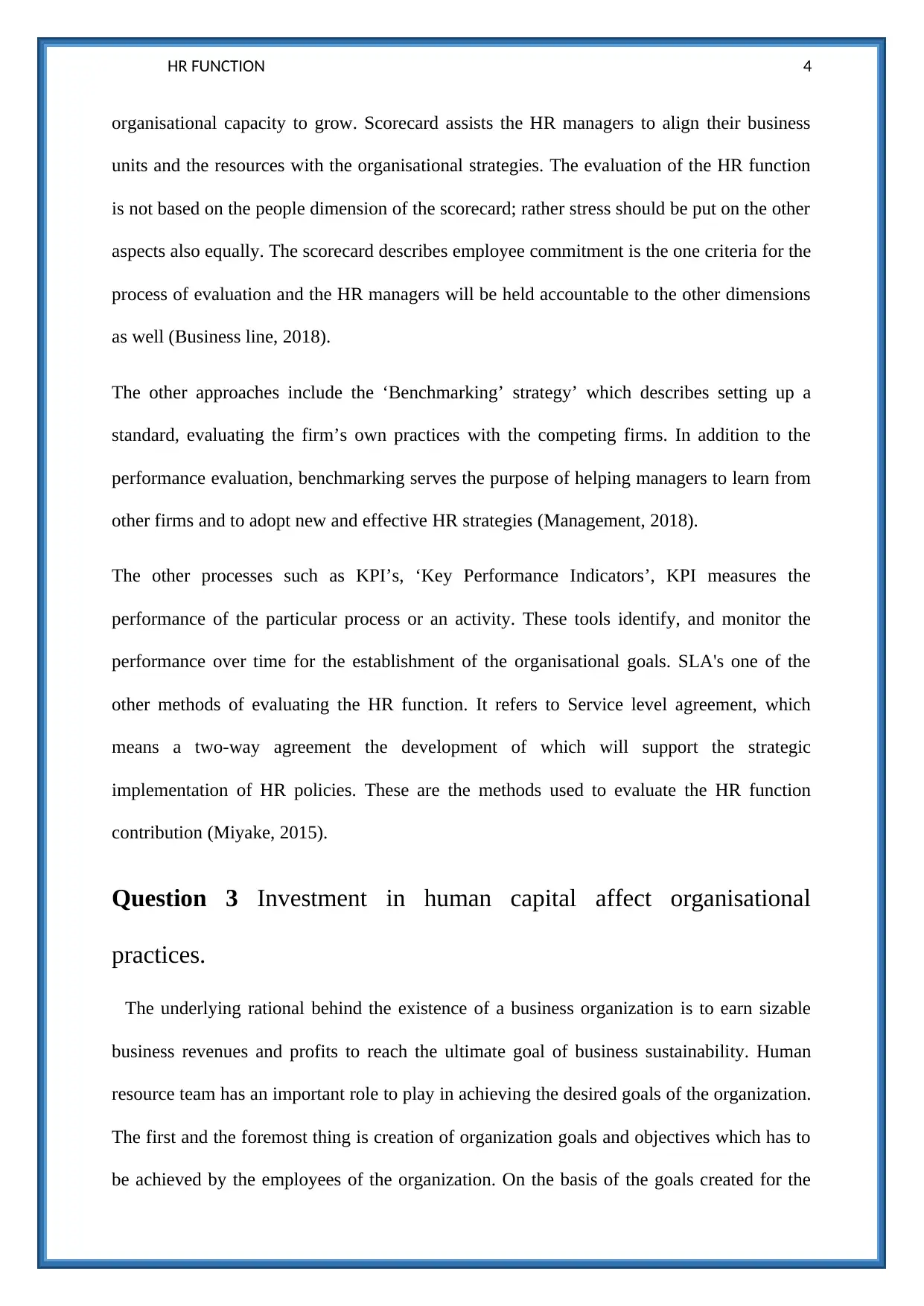
HR FUNCTION 4
organisational capacity to grow. Scorecard assists the HR managers to align their business
units and the resources with the organisational strategies. The evaluation of the HR function
is not based on the people dimension of the scorecard; rather stress should be put on the other
aspects also equally. The scorecard describes employee commitment is the one criteria for the
process of evaluation and the HR managers will be held accountable to the other dimensions
as well (Business line, 2018).
The other approaches include the ‘Benchmarking’ strategy’ which describes setting up a
standard, evaluating the firm’s own practices with the competing firms. In addition to the
performance evaluation, benchmarking serves the purpose of helping managers to learn from
other firms and to adopt new and effective HR strategies (Management, 2018).
The other processes such as KPI’s, ‘Key Performance Indicators’, KPI measures the
performance of the particular process or an activity. These tools identify, and monitor the
performance over time for the establishment of the organisational goals. SLA's one of the
other methods of evaluating the HR function. It refers to Service level agreement, which
means a two-way agreement the development of which will support the strategic
implementation of HR policies. These are the methods used to evaluate the HR function
contribution (Miyake, 2015).
Question 3 Investment in human capital affect organisational
practices.
The underlying rational behind the existence of a business organization is to earn sizable
business revenues and profits to reach the ultimate goal of business sustainability. Human
resource team has an important role to play in achieving the desired goals of the organization.
The first and the foremost thing is creation of organization goals and objectives which has to
be achieved by the employees of the organization. On the basis of the goals created for the
organisational capacity to grow. Scorecard assists the HR managers to align their business
units and the resources with the organisational strategies. The evaluation of the HR function
is not based on the people dimension of the scorecard; rather stress should be put on the other
aspects also equally. The scorecard describes employee commitment is the one criteria for the
process of evaluation and the HR managers will be held accountable to the other dimensions
as well (Business line, 2018).
The other approaches include the ‘Benchmarking’ strategy’ which describes setting up a
standard, evaluating the firm’s own practices with the competing firms. In addition to the
performance evaluation, benchmarking serves the purpose of helping managers to learn from
other firms and to adopt new and effective HR strategies (Management, 2018).
The other processes such as KPI’s, ‘Key Performance Indicators’, KPI measures the
performance of the particular process or an activity. These tools identify, and monitor the
performance over time for the establishment of the organisational goals. SLA's one of the
other methods of evaluating the HR function. It refers to Service level agreement, which
means a two-way agreement the development of which will support the strategic
implementation of HR policies. These are the methods used to evaluate the HR function
contribution (Miyake, 2015).
Question 3 Investment in human capital affect organisational
practices.
The underlying rational behind the existence of a business organization is to earn sizable
business revenues and profits to reach the ultimate goal of business sustainability. Human
resource team has an important role to play in achieving the desired goals of the organization.
The first and the foremost thing is creation of organization goals and objectives which has to
be achieved by the employees of the organization. On the basis of the goals created for the
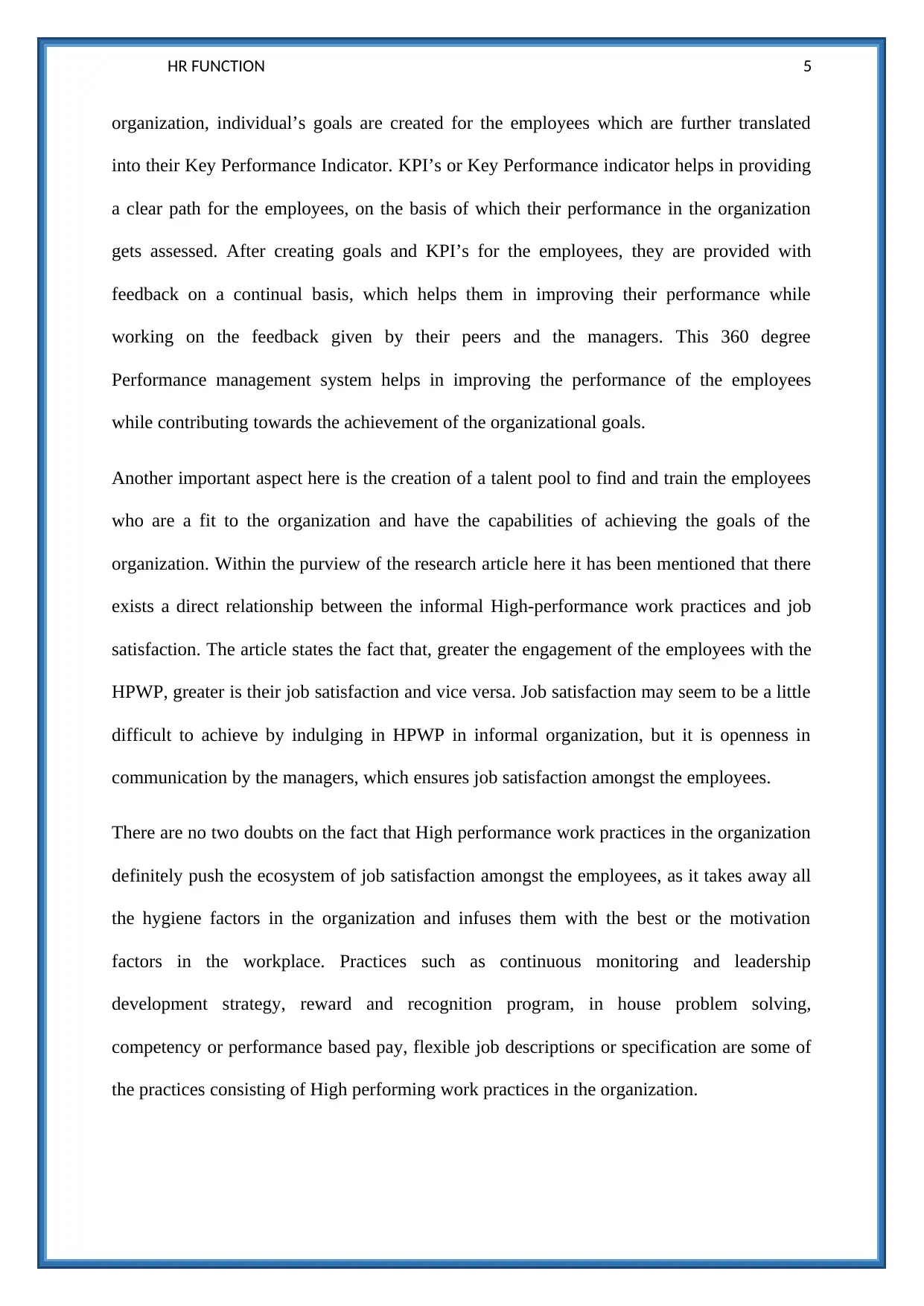
HR FUNCTION 5
organization, individual’s goals are created for the employees which are further translated
into their Key Performance Indicator. KPI’s or Key Performance indicator helps in providing
a clear path for the employees, on the basis of which their performance in the organization
gets assessed. After creating goals and KPI’s for the employees, they are provided with
feedback on a continual basis, which helps them in improving their performance while
working on the feedback given by their peers and the managers. This 360 degree
Performance management system helps in improving the performance of the employees
while contributing towards the achievement of the organizational goals.
Another important aspect here is the creation of a talent pool to find and train the employees
who are a fit to the organization and have the capabilities of achieving the goals of the
organization. Within the purview of the research article here it has been mentioned that there
exists a direct relationship between the informal High-performance work practices and job
satisfaction. The article states the fact that, greater the engagement of the employees with the
HPWP, greater is their job satisfaction and vice versa. Job satisfaction may seem to be a little
difficult to achieve by indulging in HPWP in informal organization, but it is openness in
communication by the managers, which ensures job satisfaction amongst the employees.
There are no two doubts on the fact that High performance work practices in the organization
definitely push the ecosystem of job satisfaction amongst the employees, as it takes away all
the hygiene factors in the organization and infuses them with the best or the motivation
factors in the workplace. Practices such as continuous monitoring and leadership
development strategy, reward and recognition program, in house problem solving,
competency or performance based pay, flexible job descriptions or specification are some of
the practices consisting of High performing work practices in the organization.
organization, individual’s goals are created for the employees which are further translated
into their Key Performance Indicator. KPI’s or Key Performance indicator helps in providing
a clear path for the employees, on the basis of which their performance in the organization
gets assessed. After creating goals and KPI’s for the employees, they are provided with
feedback on a continual basis, which helps them in improving their performance while
working on the feedback given by their peers and the managers. This 360 degree
Performance management system helps in improving the performance of the employees
while contributing towards the achievement of the organizational goals.
Another important aspect here is the creation of a talent pool to find and train the employees
who are a fit to the organization and have the capabilities of achieving the goals of the
organization. Within the purview of the research article here it has been mentioned that there
exists a direct relationship between the informal High-performance work practices and job
satisfaction. The article states the fact that, greater the engagement of the employees with the
HPWP, greater is their job satisfaction and vice versa. Job satisfaction may seem to be a little
difficult to achieve by indulging in HPWP in informal organization, but it is openness in
communication by the managers, which ensures job satisfaction amongst the employees.
There are no two doubts on the fact that High performance work practices in the organization
definitely push the ecosystem of job satisfaction amongst the employees, as it takes away all
the hygiene factors in the organization and infuses them with the best or the motivation
factors in the workplace. Practices such as continuous monitoring and leadership
development strategy, reward and recognition program, in house problem solving,
competency or performance based pay, flexible job descriptions or specification are some of
the practices consisting of High performing work practices in the organization.
⊘ This is a preview!⊘
Do you want full access?
Subscribe today to unlock all pages.

Trusted by 1+ million students worldwide
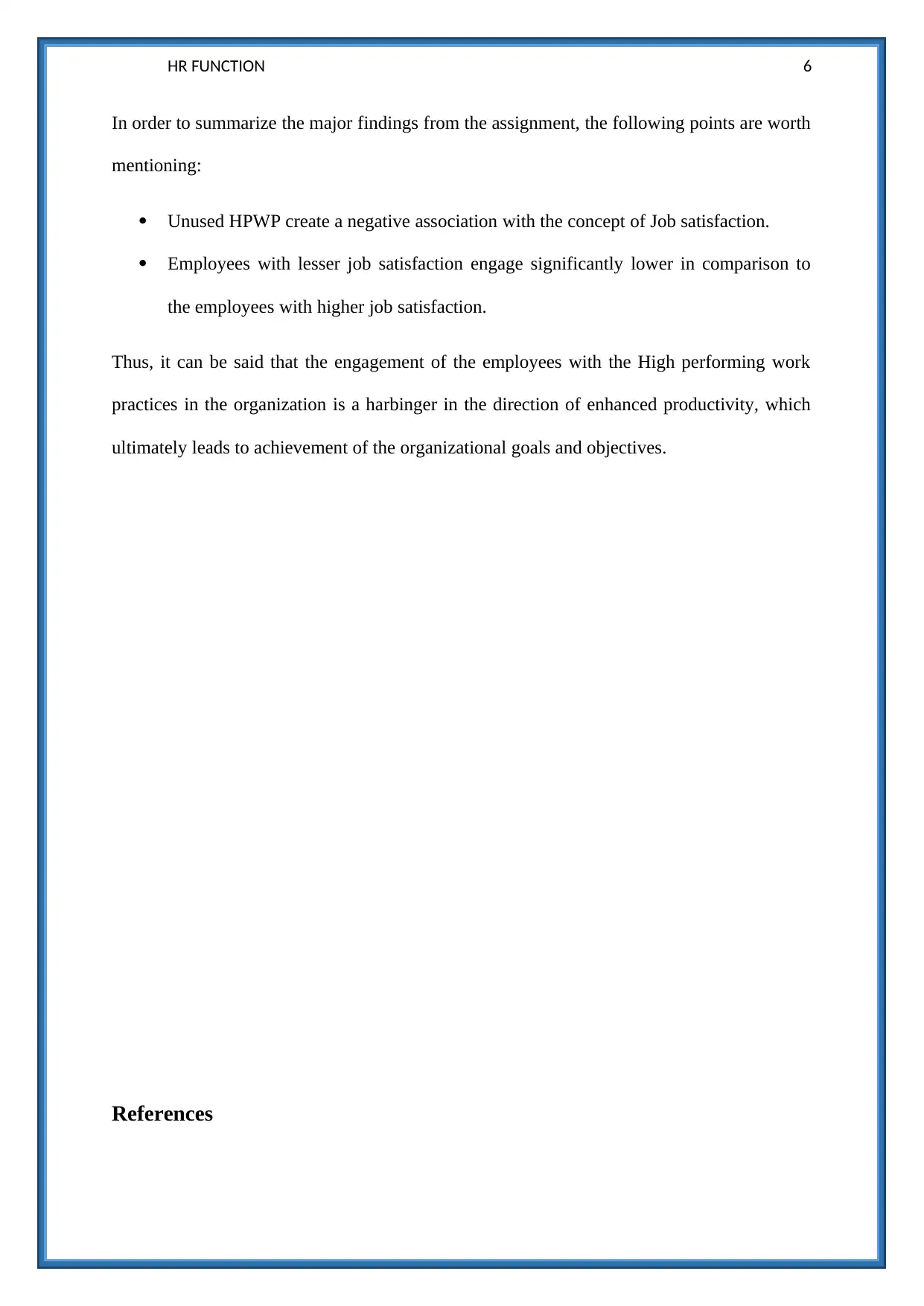
HR FUNCTION 6
In order to summarize the major findings from the assignment, the following points are worth
mentioning:
Unused HPWP create a negative association with the concept of Job satisfaction.
Employees with lesser job satisfaction engage significantly lower in comparison to
the employees with higher job satisfaction.
Thus, it can be said that the engagement of the employees with the High performing work
practices in the organization is a harbinger in the direction of enhanced productivity, which
ultimately leads to achievement of the organizational goals and objectives.
References
In order to summarize the major findings from the assignment, the following points are worth
mentioning:
Unused HPWP create a negative association with the concept of Job satisfaction.
Employees with lesser job satisfaction engage significantly lower in comparison to
the employees with higher job satisfaction.
Thus, it can be said that the engagement of the employees with the High performing work
practices in the organization is a harbinger in the direction of enhanced productivity, which
ultimately leads to achievement of the organizational goals and objectives.
References
Paraphrase This Document
Need a fresh take? Get an instant paraphrase of this document with our AI Paraphraser
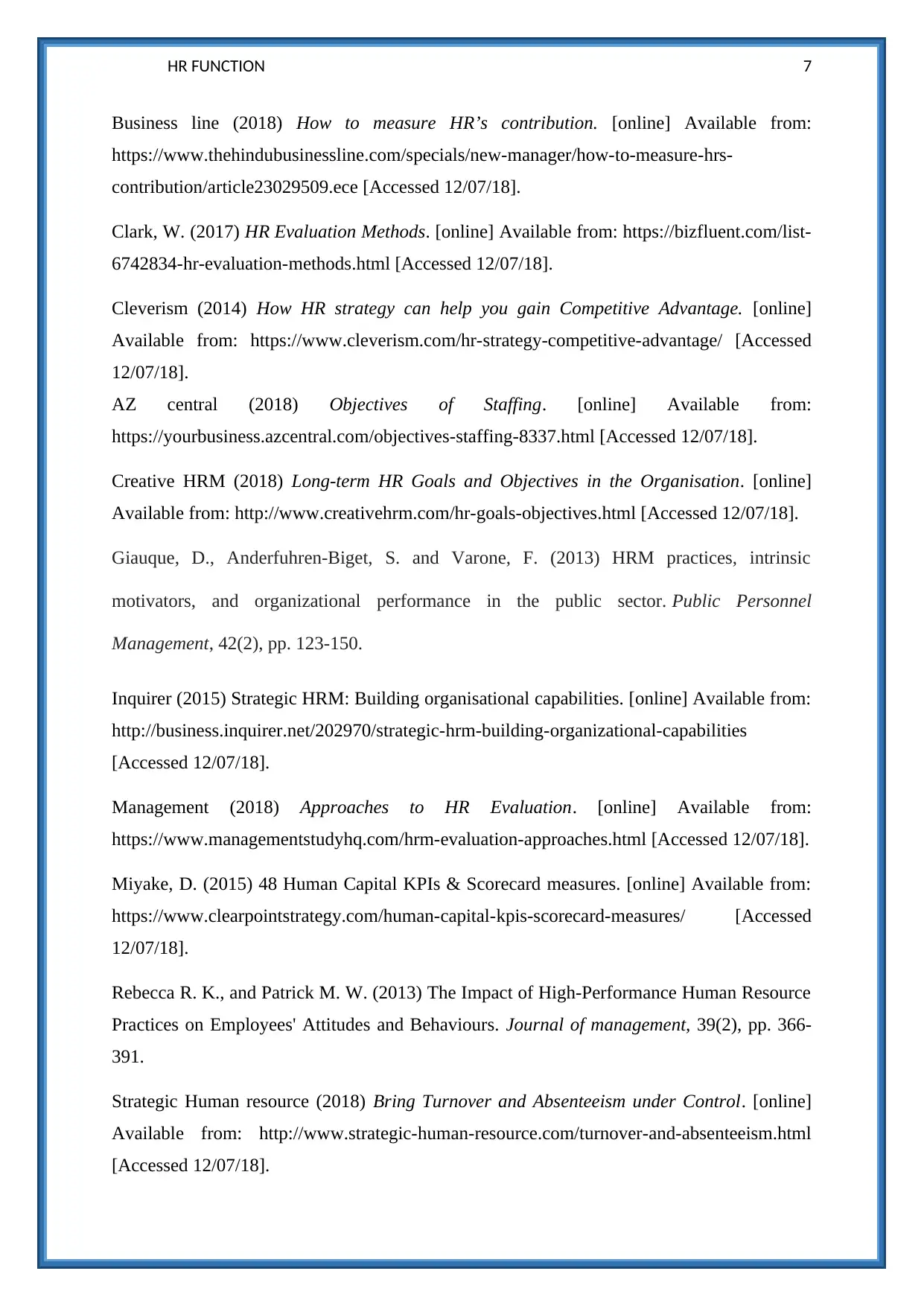
HR FUNCTION 7
Business line (2018) How to measure HR’s contribution. [online] Available from:
https://www.thehindubusinessline.com/specials/new-manager/how-to-measure-hrs-
contribution/article23029509.ece [Accessed 12/07/18].
Clark, W. (2017) HR Evaluation Methods. [online] Available from: https://bizfluent.com/list-
6742834-hr-evaluation-methods.html [Accessed 12/07/18].
Cleverism (2014) How HR strategy can help you gain Competitive Advantage. [online]
Available from: https://www.cleverism.com/hr-strategy-competitive-advantage/ [Accessed
12/07/18].
AZ central (2018) Objectives of Staffing. [online] Available from:
https://yourbusiness.azcentral.com/objectives-staffing-8337.html [Accessed 12/07/18].
Creative HRM (2018) Long-term HR Goals and Objectives in the Organisation. [online]
Available from: http://www.creativehrm.com/hr-goals-objectives.html [Accessed 12/07/18].
Giauque, D., Anderfuhren-Biget, S. and Varone, F. (2013) HRM practices, intrinsic
motivators, and organizational performance in the public sector. Public Personnel
Management, 42(2), pp. 123-150.
Inquirer (2015) Strategic HRM: Building organisational capabilities. [online] Available from:
http://business.inquirer.net/202970/strategic-hrm-building-organizational-capabilities
[Accessed 12/07/18].
Management (2018) Approaches to HR Evaluation. [online] Available from:
https://www.managementstudyhq.com/hrm-evaluation-approaches.html [Accessed 12/07/18].
Miyake, D. (2015) 48 Human Capital KPIs & Scorecard measures. [online] Available from:
https://www.clearpointstrategy.com/human-capital-kpis-scorecard-measures/ [Accessed
12/07/18].
Rebecca R. K., and Patrick M. W. (2013) The Impact of High-Performance Human Resource
Practices on Employees' Attitudes and Behaviours. Journal of management, 39(2), pp. 366-
391.
Strategic Human resource (2018) Bring Turnover and Absenteeism under Control. [online]
Available from: http://www.strategic-human-resource.com/turnover-and-absenteeism.html
[Accessed 12/07/18].
Business line (2018) How to measure HR’s contribution. [online] Available from:
https://www.thehindubusinessline.com/specials/new-manager/how-to-measure-hrs-
contribution/article23029509.ece [Accessed 12/07/18].
Clark, W. (2017) HR Evaluation Methods. [online] Available from: https://bizfluent.com/list-
6742834-hr-evaluation-methods.html [Accessed 12/07/18].
Cleverism (2014) How HR strategy can help you gain Competitive Advantage. [online]
Available from: https://www.cleverism.com/hr-strategy-competitive-advantage/ [Accessed
12/07/18].
AZ central (2018) Objectives of Staffing. [online] Available from:
https://yourbusiness.azcentral.com/objectives-staffing-8337.html [Accessed 12/07/18].
Creative HRM (2018) Long-term HR Goals and Objectives in the Organisation. [online]
Available from: http://www.creativehrm.com/hr-goals-objectives.html [Accessed 12/07/18].
Giauque, D., Anderfuhren-Biget, S. and Varone, F. (2013) HRM practices, intrinsic
motivators, and organizational performance in the public sector. Public Personnel
Management, 42(2), pp. 123-150.
Inquirer (2015) Strategic HRM: Building organisational capabilities. [online] Available from:
http://business.inquirer.net/202970/strategic-hrm-building-organizational-capabilities
[Accessed 12/07/18].
Management (2018) Approaches to HR Evaluation. [online] Available from:
https://www.managementstudyhq.com/hrm-evaluation-approaches.html [Accessed 12/07/18].
Miyake, D. (2015) 48 Human Capital KPIs & Scorecard measures. [online] Available from:
https://www.clearpointstrategy.com/human-capital-kpis-scorecard-measures/ [Accessed
12/07/18].
Rebecca R. K., and Patrick M. W. (2013) The Impact of High-Performance Human Resource
Practices on Employees' Attitudes and Behaviours. Journal of management, 39(2), pp. 366-
391.
Strategic Human resource (2018) Bring Turnover and Absenteeism under Control. [online]
Available from: http://www.strategic-human-resource.com/turnover-and-absenteeism.html
[Accessed 12/07/18].
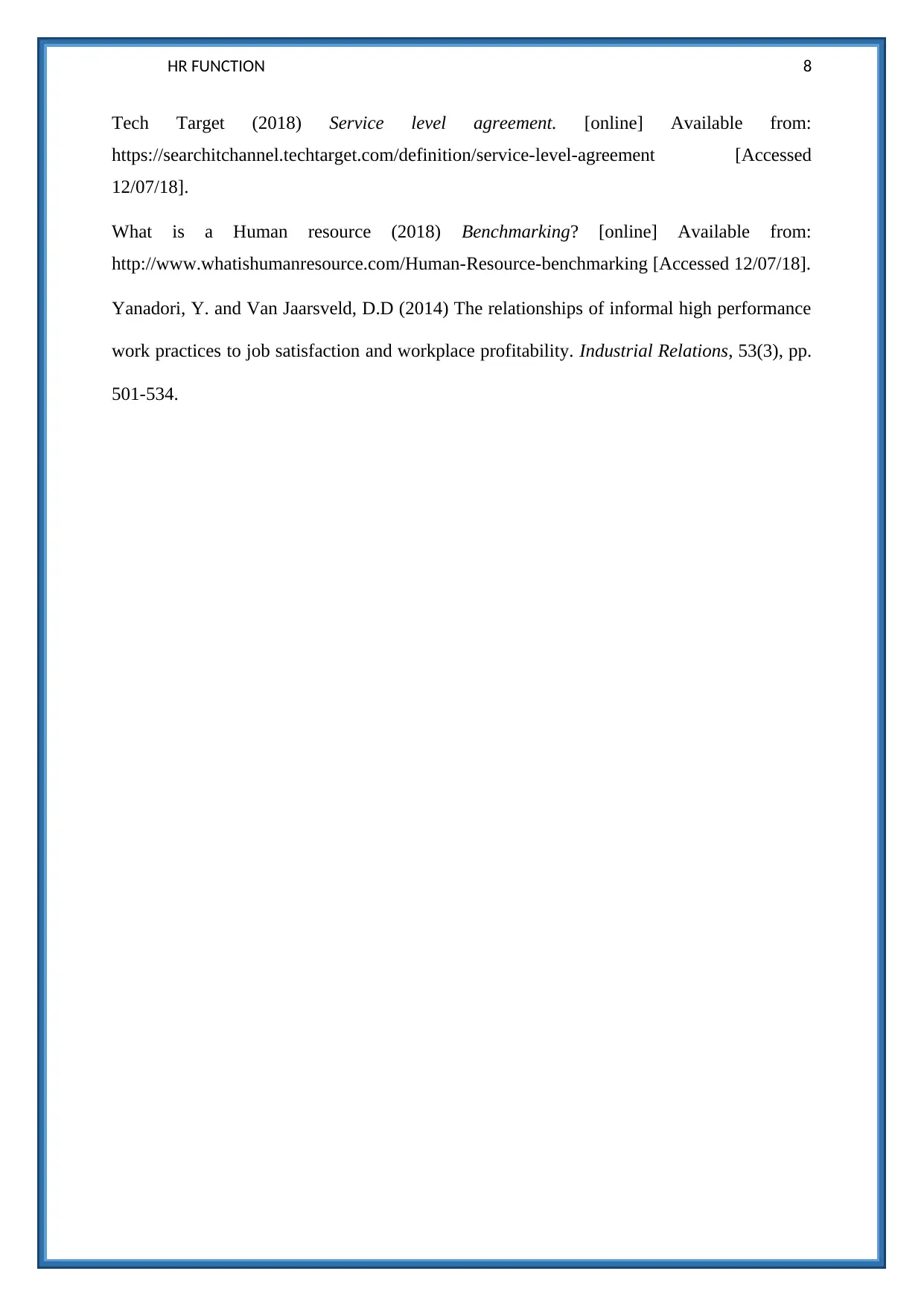
HR FUNCTION 8
Tech Target (2018) Service level agreement. [online] Available from:
https://searchitchannel.techtarget.com/definition/service-level-agreement [Accessed
12/07/18].
What is a Human resource (2018) Benchmarking? [online] Available from:
http://www.whatishumanresource.com/Human-Resource-benchmarking [Accessed 12/07/18].
Yanadori, Y. and Van Jaarsveld, D.D (2014) The relationships of informal high performance
work practices to job satisfaction and workplace profitability. Industrial Relations, 53(3), pp.
501-534.
Tech Target (2018) Service level agreement. [online] Available from:
https://searchitchannel.techtarget.com/definition/service-level-agreement [Accessed
12/07/18].
What is a Human resource (2018) Benchmarking? [online] Available from:
http://www.whatishumanresource.com/Human-Resource-benchmarking [Accessed 12/07/18].
Yanadori, Y. and Van Jaarsveld, D.D (2014) The relationships of informal high performance
work practices to job satisfaction and workplace profitability. Industrial Relations, 53(3), pp.
501-534.
⊘ This is a preview!⊘
Do you want full access?
Subscribe today to unlock all pages.

Trusted by 1+ million students worldwide
1 out of 9
Related Documents
Your All-in-One AI-Powered Toolkit for Academic Success.
+13062052269
info@desklib.com
Available 24*7 on WhatsApp / Email
![[object Object]](/_next/static/media/star-bottom.7253800d.svg)
Unlock your academic potential
Copyright © 2020–2025 A2Z Services. All Rights Reserved. Developed and managed by ZUCOL.




